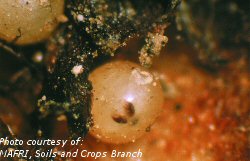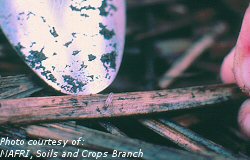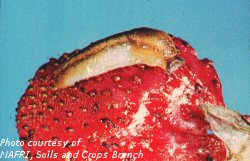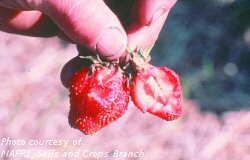Slugs

Slug egg

Slug on straw

Slug on strawberry

Slug damage to strawberry
Host Plants And Distribution
Depending upon the location, there may be several species of slugs that cause problems. The most commonly reported slug in the literature is the grey garden slug, Deroceras reticulatum. In Manitoba, the primary pest is the grey field slug, Deroceras laeve. Slugs are found in virtually all areas of North America, preferring humid environments. Host plants include a variety of horticultural and ornamental plants, but slugs will be discussed here as they relate to strawberries.
Biology
Slugs are legless, soft-bodied invertebrates that glide along on a trail of secreted mucus. Their tell-tale trails appear as dry silvery, meandering pathways in the daylight. Their trails may cover soil, leaves, and fruit. The marsh slug is the common species infesting strawberries in Manitoba. This light-brown to dark-grey slug is about 15 mm long when fully grown.
Life histories vary depending upon the species. The two species of Deroceras mentioned above have a similar life cycle. Adult marsh slugs are abundant immediately after snow melt, but quickly become scarce. Eggs are laid on damp soil and organic matter during June and July. During picking time (late June – early July), both eggs and larvae are present. Slugs reach a length of about 15 mm in Manitoba and vary in colour from white to brown to grey. In other regions there may be considerable variation. Slugs are smooth bodied and generally leave a slime trail behind, along the path they have travelled.
Symptoms nd Damage
Slugs can be a serious problem in wet areas of a non-irrigated field, throughout an irrigated field, and during lengthy periods of wet weather. Slugs are most damaging to young plants but will attack strawberry plants at any stage of their growth. Besides the direct yield losses due to slug feeding damage on plants, indirect loss can also occur because of the contamination of fruit by slug faeces and slug "slime". Such cosmetic damage can render strawberries unacceptable for human consumption. Most pickers will not pick or will quickly discard any damaged berries or berries with slugs on them.
Signs of infestation include split and shredded leaves, slime trails and presence of slugs on berries. Slugs are most problematic in wet years or heavily irrigated fields. Damage is caused in two ways: first, by direct feeding damage to berries and second, by contamination of feces and the slime trails, which are cosmetically unappealing. Damage attributed to slugs is difficult to estimate because of the interaction of other factors, including poor weather conditions, diseases and other pests.
Scouting Techniques
Slugs will hide during periods of hot dry weather and may be difficult to find. To inspect for slug eggs, look under the straw layer between rows. Eggs will be visible as small, round, translucent balls.
Economic Thresholds
Careful examination of an area will give a good estimate of slug density. Although no action threshold is available for slugs, 50 or more slugs per m2 indicates a badly-infested field. Most growers take action if any slugs are observed.
Comments
Slug problems can be minimized through good crop management practices. Avoid over-irrigation of the crops. Avoid planting in areas that are perennially wet spots. Use rotovation at renovation time (rather than minimum tillage) to reduce crop refuse and straw build-up on the soil surface in fields prone to slug infestations. Use cultivated soil borders around the margins of strawberry fields to minimize the inward movement of slugs. Crop rotation does not seem to be a practical solution to slug management because most species of slugs feed on a wide variety of plants. Thoroughly clean equipment used in a slug-infested field to prevent the introduction of eggs or slugs into your other fields. Manage adjacent shelterbelts to minimize slug habitats. Remove low shrub and weed growth to reduce the amount of thick organic litter on the soil surface of shelterbelts.

